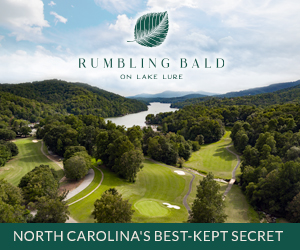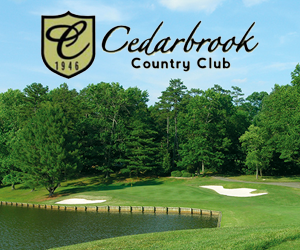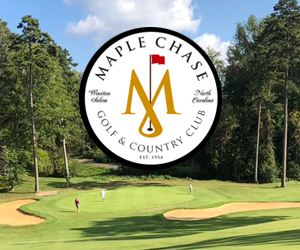By John Brasier
Pawleys Plantation … Long Bay Club …Tidewater …
If you’re a Triad golfer, you’ve probably played the above listed Myrtle Beach golf courses. If you haven’t, you should – they are a trio of the top accessible layouts on the Grand Strand. Pawleys Plantation and Long Bay are the only Jack Nicklaus designs on the Grand Strand.
As we head into the fall season, each of the three courses is either undergoing improvements – or has recently reopened after extensive improvements.
Here’s an individual look at projects after mid-September visits.
PAWLEYS PLANTATION
Starting south, Pawleys Plantation, was one of the Nicklaus designs to get new TifEagle – the strand of Bermuda suggested by the Golden Bear himself – on its restored greens.
Founders Group International, the owner of 21 Grand Strand courses – is finishing up a multimillion renovation of Pawleys Plantation that restored the size (about 48%) of the shrinking greens, redid fairway and greenside bunkers, eliminated 10 sprawling, but mostly cosmetic, waste/sand bunkers and cleared out many small encroaching trees.
The course, which winds through scenic salt marsh and between stately live oaks, is expected to reopen in mid-October.
A new Tahoma 419 Bermuda collar around the greens will separate the fairways from the putting surfaces, making it easy for mowers to see the edges of the putting surfaces, reducing the chances of losing the outer edges to mowing.
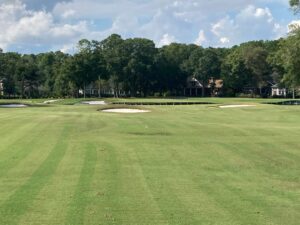
New sod has replaced the huge bunker that had stretched from the water in front of the 10th green at Pawleys Plantationfor as much as 100 yards, leaving a difficult approach, especially for high handicapper.s
No, the big live oak in the middle of No. 9 fairway remains, as does the last of three live oaks that have guarded the approach on the par-5 11th.
The course has a cleaner look and should be much more playable for mid-to-high handicappers while remaining a test for better players. Sod has replaced some sand areas that extended as much as 100 yards along the fairways. New greenside bunkers, with capillary concrete drainage systems, provide a challenge on approaches.
General manager Riley Kinlaw said Jack Nicklaus visited the course in 2018 to help plan the changes.
“The teeth of the course is still there,” said Kinlaw said, noting that the elimination of long waste bunkers would help high handicappers the most.
The sand removal is most obvious at No. 10, a short par-4 where sand stretched more than 100 yards from fairway, serving as a major obstacle for high-handicappers who were faced with a forced carry over water from the sand to a green more than 100 yards away.
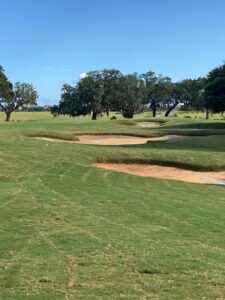
Several holes at Pawleys Plantation have lush sod in places where sand terrorized high handicappers.
The dike that serves as the tee box for the par-3 13th and 17th holes remains, but a small section of tee box has been removed to make the designation between the tee boxes easy to see and provide additional room for carts when both tees are occupied.
A new addition, including an outdoor deck, has been built for the snack bar/19th hole. Cart paths, bridges and restrooms were included in the renovations.
Kinlaw said he expects the updated Nicklaus layout to rank with TPC Myrtle Beach and Grande Dunes Resort Club at the top of the Founders Group pecking order, which also includes Long Bay Club and King’s North.
“This is going to be, in my opinion, one of the best courses in the area, if not, the best course,” Kinlaw said.
LONG BAY CLUB
Founders Group’s work at Long Bay consisted mostly of new TifEagle putting surfaces, replacing Champion Bermuda grass planted 17 years earlier at the course off S.C. 9 in Longs. Other renovations were made, including the updating of bunkers and cart paths.
Closed May 22 and reopened August 12, Long Bay also had Tahoma 19 collars installed to help maintain the size of its putting surfaces.
Some removal of trees and overgrowth are noticeable on Nos. 13-15, arguably Long Bay’s most scenic stretch of holes that meander around a creek.
Golf professional Brandon Mensinger said poa annua and other grasses had gradually encroached on the greens, which were restored to about 110,000 square feet from the 66,000 SF they were before the restoration.
“We did really well. With the heat and humidity, we couldn’t have asked for much better,” Mensinger said.
TIDEWATER
Not much has changed on the surface at Tidewater, and that’s by design, according to new owner Kemper Sports, which paid a reported $6.75 million – yes, the property is spectacular – in August for the course.
Like Pawleys Plantation, Tidewater is blessed with breathtaking scenery, a challenging design and a big reputation.
Though the course has matured a bit over the past three decades, and more homes are visible, though mostly far from play, the Cherry Grove Beach course has retained much of the momentum it opened with in 1990.
Tidewater’s reputation as one of the Grand Strand’s elite courses made it especially attractive to Kemper Sports, which operates about 100 public and private courses in the U.S., including Bandon Dunes, Streamsong and Chambers Bay.
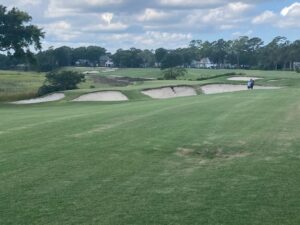
The par-3 third hole at Tidewater requires a short, but accurate shot to a two-tiered green perched above Cherry Grove Inlet.
With holes meandering through wetlands along Cherry Grove Inlet separating the course from the beach and the Intracoastal Waterway, Tidewater is special. For years, in various surveys, golfers have rated the par-3 third and par-4 fourth holes along the inlet as two of the Strand’s best holes.
“This is an ‘ain’t broke, don’t fix it,’ situation,” Jeremy Goldblatt, chief operating officer of Kemper Sports, told Triad Golf. “We’re not trying to change things drastically right now.”
In North Carolina, it manages Sequoyah National in Whittier. Tidewater is Kemper’s first course in South Carolina.
“I don’t know why we haven’t had more penetration in the Carolinas,” Goldblatt said. “There’s a chance for this to be a little beachhead. We’d love to grow and find other (Carolinas) properties.”


